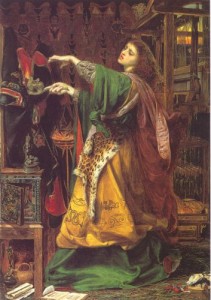
Recently I received an enquiry from a seeker in Eastern Europe, where much of the traditional magical practices and folklore were wiped out under Communism. There are many seekers in the area, but not many experienced practitioners. The seeker was especially interested in older forms of magic, and asked how to tell the difference between fake and real techniques.
I replied that we don’t know everything about what people did in the past, so have had to supplement with other techniques. Also, Wicca is not an ancient religion, but an outgrowth of many different strands of magic and spirituality coming together (see Triumph of the Moon: the rise of modern Pagan witchcraft by Ronald Hutton).
Even reconstructionist traditions have had to supplement the writings they have with a lot of personal gnosis (which starts life as unverified, but may become substantiated, either by matching it up with traditional lore, or by finding that the experience has been shared by others).
I must also point out that not all Pagan traditions practice magic; but I do think that if you are going to practice magic, it is best embedded within a religious tradition.
Some books of magic from the medieval period survive. Some 19th century handwritten books survive; they are not books of shadows in the modern sense. Avalonia Books are translating and publishing some of them. One very interesting book documenting 18th century fairy beliefs is The Secret Commonwealth of Elves, Fauns and Fairies by Robert Kirk. Another very interesting book is by a Finnish traditional witch, and is called Snake Fat and Knotted Threads by Kati-Ma Koppana, describing what survived of Finnish witchcraft. I also recommended Practical Magic in the Northern Tradition by Nigel Pennick.
The Pagan revival is a new thing building on old ideas. Paganism was wiped out in Europe by forced conversion and (in some areas) slaughter and persecution. However, many of its ideas, stories, and techniques survived – written down by Christian monks and antiquarians like Snorri Sturluson, or retained as folk customs and practices. The Christians who wrote down these ideas sometimes did so from second-hand hearsay, and sometimes tried to explain away Pagan deities as ancient kings and queens. Folk customs only began to be recorded systematically in the late nineteenth century, so in many cases, it is not clear how old they are, or how much they may have changed in the intervening centuries. The good news is that Pagan traditions are a human response to the land and its other-than-human inhabitants; even if all the books and stories disappeared, Paganism is inscribed in the land itself and our response to it, as John Male once said to me. That is why the old deities and the old customs would not, could not, lie down and die. People will always respond to the land in a magical and mystical way.
If you want old and traditional, start by researching the folk magic of your region. The seasonal festivals; the protective magic people did for their crops and livestock. If this information is not available from older people, it may have been collected by folklore collectors in the late 19th and early 20th centuries. But bear in mind that tradition is dynamic and fluid and always changing – it is not a fixed thing.
Older descriptions of magical techniques are not necessarily better than newer descriptions, and in any case, the newer books are generally based on older books, and draw upon them. The trick is to distinguish between fake and real. If it claims to be an old and unbroken tradition, it is very likely to be fake. If it has references to academic works, it is probably real. If it is realistic and moderate in its claims, it’s probably real. If it claims to be the solution to all your problems – that’s fake. If it wants to charge you money for Wiccan training – that is fake. Real Wicca does not cost money; face-to-face participatory coven training is free, though you would be asked to bring food to share, and perhaps contribute to the cost of candles and incense. You would be charged a modest fee for things like workshops and day courses, to cover the speaker’s time and travel expenses.
People assume that older traditions are better than newer ones, but this is not necessarily the case. Everything was new once. For me, the test of whether any tradition is any good is: does it work? does it help (in the long term as well as the short term)? Is it a coherent system? Does it both challenge and empower its participants? If you want to understand the underlying theory of magic, I would recommend Isaac Bonewits’ The Laws of Magic.
Magical techniques include visualisation, invocation, protection magic, cleansing, sigils, talismans, and divination. These techniques are very old and were used by most magical practitioners from ancient times to the present. They have been presented in new styles by a number of different writers; but they are essentially the same techniques. I once bought a book about witchcraft and magic in Russia, called The Bath-house at Midnight, thinking that Russian magic would be very exotic and different. I was disappointed to find that it drew on the same sources and almanacs as much of the folk magic of Western Europe.
I also recommended that the enquirer should contact the Pagan Federation International to find like-minded people. If you are in a similar situation, I would recommend you do the same.











